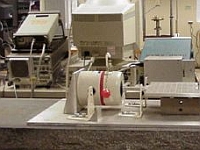Teaching

|
Raymond de Callafon also brings the practical application of model identification and control design techniques to his classes via demos and the possibility to work with actual experimental data or physical systems available in his laboratory. Next to the regular classroom based courses, laboratory courses are being taught to cover the experimental aspects. For that purpose, experiments in specific (undergraduate) laboratory courses (MAE171a, MAE175a, MAE171b, MAE156b and ECE191) and the facilities of the Undergraduate and Graduate Control Laboratory (UGCL) are maintained by Raymond de Callafon.
During the Summer of 2011, Prof. de Callafon is teaching the COSMOS cluster on Engineering Design and Control of Kinetic Sculptures, followed by the undergradute course MAE143 on Linear Control. Currently, in the Winter Quarter of 2012 Prof. de Callafon is teaching the undergraduate laboratory course MAE175a with topics on Control, Vibration and Linear Circuit analysis. A summary of courses taught by Prof. de Callafon is listed below.
Graduate Courses
The following graduate courses have been taught by Prof. de Callafon:- MAE283a, Parametric Identification - theory and tools, taught in 1999, 2000, 2001, 2003, 2005, 2006, 2007, 2008, 2009, 2010 and 2011.
-
MAE283b, Approximate Identification and Control or Identification
for Control is taught bi-annually and was given in
2001 (together with Prof.
Bitmead),
2005,
2008 and
2010.
This course has been scheduled to be taught by Prof. Bitmead during the 2012 Spring session. -
MAE284, Robust and Multivariable Control,
taught in 2000
and
2003.
This course has been scheduled to be taught by Prof. de Callafon during the 2012 Spring session. - MAE291 co-teaching in 2001, 2003 and 2005.
One is invited to click on one of the class numbers to get a more detailed description about the classes and course contents. The different years refer to the class website of the different years in which the classes were taught. They provide an excellent resourse for past exams, homework sets and lecture notes.
Undergraduate Courses
The following undergraduate (laboratory) courses have been taught by Prof. de Callafon:- MAE1, Introduction to Engineering taught in 1999 and 2000.
- AMES141b, Digital Control Systems , taught in 1999.
- MAE171a, Mechanical Engineering Laboratory and later Mechanical and Aerospace Engineering Laboratory, taught in 1999, 2000, 2001, 2002, 2003, 2004 and 2005.
- MAE175a, Mechanical and Aerospace Engineering Laboratory Course, (along with partial responsability for MAE171a) taught in 2006, 2007, 2008, 2009, 2010, 2011 and currently being taught in the Winter Quarter of 2012.
- MAE171b, Advanced Mechanical Engineering Laboratory, taught in 1999, 2000, 2001, 2002, 2003, 2004, 2005, 2006, 2007 and 2008. After 2008 the course has been changed to a Technical Elective for MAE students. This course has been scheduled to be co-taught by Prof. de Callafon during the 2012 Spring session.
- MAE143b, Linear Control - Theory and Applications, co-taught in 2002 and in the summer sessions of 2008, 2009, 2010 and 2011.
- MAE156b, Fundamental Principles of Mechanical Design II, project participation in 2003, 2008 and 2009. The website for MAE156b is maintained by the most recent course instructors.
- CENG120, Chemical Process Dynamics and Control taught in 2003 and 2004. After 2004, the course has been cross-listed with MAE143b.
Undergraduate and Graduate Control Laboratory

|
| Vibration and data acquistion hardware for teaching purposes in the UGCL |
The hardware in the laboratory has special interface software and numerous thought-provoking experiments for the study of dynamics and mechanical vibrations. The equipment in the laboratory has many advanced system I/O and data processing capabilities. As a result, the experiments in the laboratory are used to generate experimental data for instructional purposes in several courses both at the graduate and undergraduate level. In addition, the experiments are used interactively by students to study problems of data-based modeling, dynamic system identification, vibration analysis and real-time control in a laboratory environment. For more information, see also the webpage of the UGCL.
COSMOS - Engineering Design and Control of Kinetic Sculptures

|
| Close-up image of a structure used in the COSMOS cluster on Design and Control of Kinetic Sculptures |
As part of the annual COSMOS program, Prof. de Callafon and Dr. Delson have been teaching the cluster on Engineering Design and Control of Kinetic Sculptures since 2005. The cluster teaches students to analyse, design and build actual working devices of mechanical kinetic scultptures and interface them with sensors, actautors and a microprocessor to learn the basic concepts behind decision and control algorithms applied to a mechanical system.
The cluster uses the MAE Design Studio for manufacturing and design of mechanical parts on a LASERcamm Rapid Prototyping machine. Students learn the physics behind moving objects and learn how to program a microcontroller for processing optical sensor information and the active control of the Kinetic Sculpture. More information can be found on the cluster webpage on Engineering Design and Control of Kinetic Sculptures.